Stylish retro revamp of firm’s GSX-S1000 roadster looks great and goes well, but small fuel tank lets it down
Prejudice is a terrible thing. It can lead to unfairness at work, miscarriages of justice, or even worse crimes. And while its impacts in this line of work – testing motorbikes – are far, far less important, it’s still something we strive against. Even when it’s really (really) hard.
The Suzuki Katana has been perhaps the most obvious case in recent years for me.
It’s a perfect storm situation – the original 1980s Katana is one of the most evocative designs ever, with a big place in the heart of any biker born (like me) in the 1970s.
It was a big-boned, high-performance superbike from the dinosaur era of massive air-cooled engines, twin-shock rear suspension and steel cradle frames. But its sharp, clean design, plus the ultra-cool name (taken from a Japanese samurai sword), lifted it above the crowd.
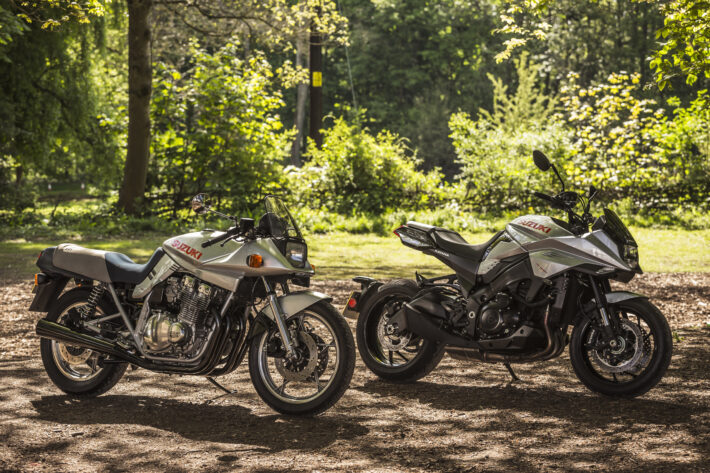
It would have looked bang up-to-date had it been launched in 2001 or even 2021, instead of 1981.
So a modern retro version seemed like an open goal for Suzuki, especially nowadays. Stuff like Kawasaki’s Z900RS, Triumph’s various classic twins and the Royal Enfield 650 twins are selling like disposable facemasks, and the market has loved a retro design for a good few years now.
When I heard it was coming then, I was already dangerously prejudiced in its favour; this would be a cracker. Bosh a GSX-R1000 engine into a decent high-road-spec chassis, give the styling job to some fizzing-hot automotive-design students, and watch the sales roll in.
The first two things on my wish list definitely happened – though not quite how we might have expected.
The GSX-R motor they chose was a cracker in its day – the K5 variant of the 1000, with its longer stroke layout and flawless reputation.
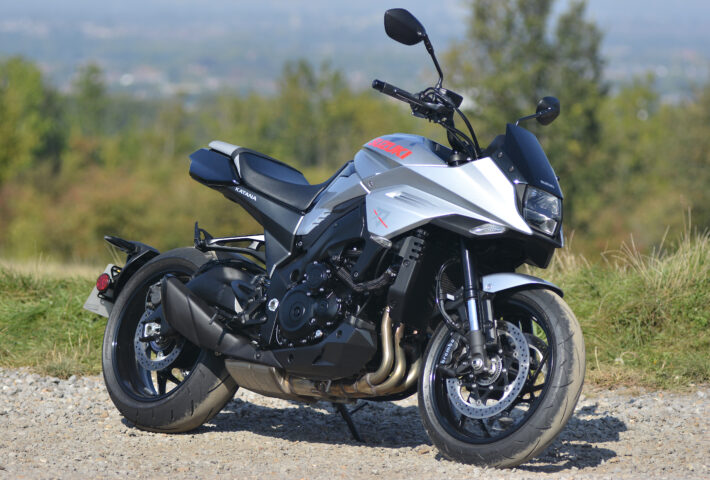
Retuned as a street bike lump that meets Euro emissions regs, it still makes a decent 150bhp, though is maybe a bit too retro in its tech, with no ride-by-wire throttle or variable valve timing as used on the modern GSX-R1000.
And the chassis also has the look of a previous-generation GSX-R, with the tasty braced swingarm off the 2016 1000, and a sporty aluminium frame, USD forks and radial Brembo calipers.
It all looked a bit familiar though – as it should be, because the engine and chassis are identical to the firm’s GSX-S1000 roadster. No bad thing – I’ve spent plenty of time on the GSX-S and it’s a great, practical, fun machine. But it’s not a bike that makes the earth move in the way an old-school Kat does.
Could Suzuki add enough pizzazz to compensate? On paper at least, maybe not.
So – my prejudices were settling in already, even before I went to pick the new Katana up from Suzuki HQ at the tail end of summer.
Now, the first thing to say is that the new Katana looks much better in the flesh – and it also grows on you.
Over the couple of weeks I spent with it, it looked sharper and classier each day, and details like the swingarm-mounted rear mudguard, beefy swingarm and (optional) Katana-embossed seat really clicked.
It’s a satisfying bike to ride too.
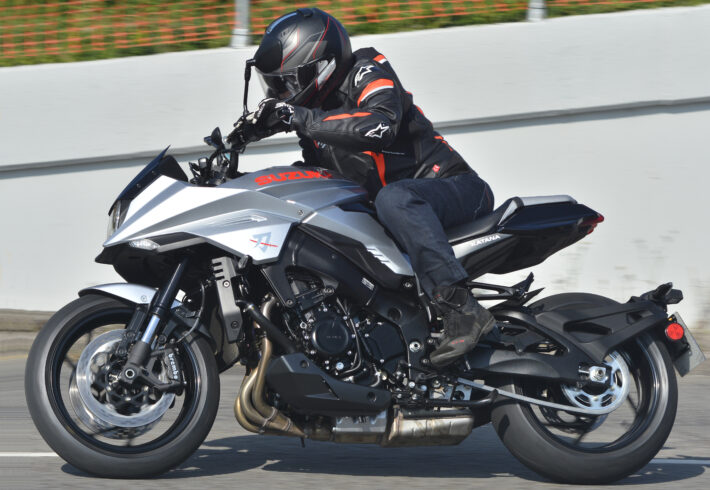
My first hundred-odd miles weren’t going to show it at its best sadly, with Milton Keynes’ dual carriageways, the M1 and the M25 only illustrating the downsides of a (nearly) naked litre bike on a motorway.
The riding position is comfy enough, with high bars and low-ish pegs, and the lack of wind protection at least saves your licence from the temptation to sit at 110mph for long.
That engine is sweet, with bags of character, decent low-down and midrange power, matched with a strong top-end. Okay, the big boys in the naked class are knocking on 200bhp these days – but a 150bhp inline-four litre engine is still a very potent piece of kit.
I’m only just off the M25 and onto the A3 when the Katana’s big problem shows up though.
When the specs first appeared, the 12 litre fuel capacity looked like a typo. But no: for some unknown reason, a tank with less than three gallons – more suited to a 125 or a dirt bike – made its way onto the Katana. It’s not even as if the modern Kat is a svelte machine with vestigial bodywork, or a curiously-sculpted peanut tank.
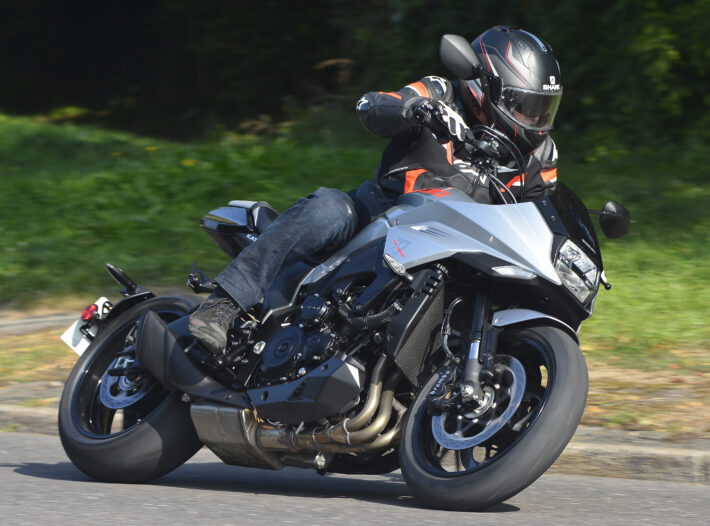
The space from the front of the seat to the forks is hyooge, with the silver panels sweeping forward over the frame rails adding to the real estate. I’m sure the engineers can explain themselves, and no doubt they tried their best to squeeze the most capacity in that they could with this styling.
But as I pull into a petrol station with less than 90 miles on the tripmeter, I’m not impressed.
Checking the official figures, Suzuki claims 53.3mpg, which would give you more than 138 miles from the tank. But with my usual riding style (certainly not going crackers), I was getting closer to 40 mpg, which is just over 100 miles till empty.
Much of the rest of my riding was round town, where the fuel capacity is much less of a problem of course.
The Katana is loads of fun in the city, just like the GSX-S1000, and there’s a real hard edge to the performance should you need it. I spent a few days pottering around, seeing chums and doing bits of work, and in pootling mode, the Katana is almost like a big cruiser.
It definitely catches the eye – even non-riders sense its design is something different and striking, while bikers are also keen to comment – chatting about the original, asking how this one goes, and generally complimenting its looks.
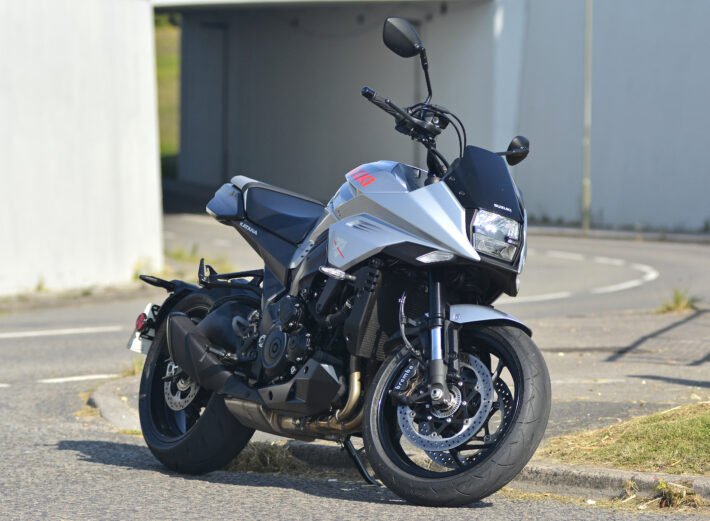
But there’s definitely another side to the Katana. Pull onto a good, quiet piece of twisty road, on a sunny morning, with the right mental attitude, and it’s a bit of a beast.
Once you get the motor running over around 8k, the Easy Rider cruiser attitude evaporates, and the K5 GSX-R1000 track spirit appears. The intake purring turns to a roar, the throttle response gets sharper, and the motor eggs you into throwing more throttle and revs at it, as fast as you like. It likes a wheelie as well, should your interests lie in that direction…
The road bike chassis does a decent job of keeping up. I’ve ridden the GSX-S1000 on a track, and it’s got limited skills there chassis-wise, but for street use, it’s more than fine.
The suspension is set part-way between budget commuter-spec kit and proper high-end sports gear, so it’s compliant over bumps and taut enough when you push on a bit.
The brakes are in the same vein: strong when needed, but with no angry aggressive initial bite. Add in the relaxed riding position and steady steering and you have a friendly, accommodating daily ride, with the ability to turn it up a fair bit on the road, when you’re in the mood.
The Katana is still a little off the levels you might expect in 2020 though.
The lack of a quickshifter, even as an option, would have been moot just a few years ago, but gearchange assistance is becoming more common, and once you use it on a bike, you do miss it. It’s not a deal breaker, but is another wee mark against the Suzuki.
Similarly, a colour LCD dash, more advanced rider aids, cruise control – they’re all there on (admittedly pricier) competitors. On a more fundamental level, it’s no lightweight: 215kg ready to ride is 10kg more than a BMW S1000R.
On the other hand, we’d obviously all love it to have 180bhp, variable valves, ride-by-wire, IMU traction and ABS and a 3D colour dashboard beamed into our eyes. But that’s not what Suzuki is doing here – it’s come up with a solid retro bike, that pays its homage to the original, and doesn’t cost a fortune.
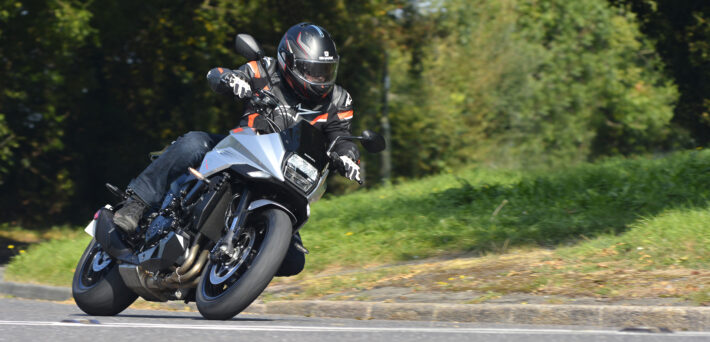
The only real complaint then is that fuel tank, which will be more or less serious depending on your circumstances.
If you live in the Highlands or Cornwall, say, 40 miles from the nearest petrol station, you’ll struggle a bit… Once you know the limitations it’s fine of course, and it’s less important if you spend your riding days merely cruising round urban and suburban areas. And on a Sunday Blast, your mates will soon learn that you’ll be first to need a stop…
The problem I see is that it’s not a situation that’s easily fixed. If you don’t like the tyres or brakes or suspension on a bike, you can swap in better parts or modify the standard components.
Ditto engines: an exhaust and mild tuning can add more power.
But there’s little you can do to improve fuel capacity: short of commissioning a replacement custom tank from someone (or bungeeing a jerry can on the pillion seat), you’re stuck with 12 litres.
There’s an easy answer of course: pick the cheaper, plain-jane GSX-S1000 instead. In ‘F’ faired form, it makes a great all-rounder, with a normal 17-litre fuel tank and better wind protection, and the same performance as the Katana.
It’s not got the style or panache though – nor the rarity.
I live in SW London, not far from Box Hill and see a load of bikes on my jaunts out. The Katana is an unusual sight though – I think I’ve maybe seen one on the road since it came out.
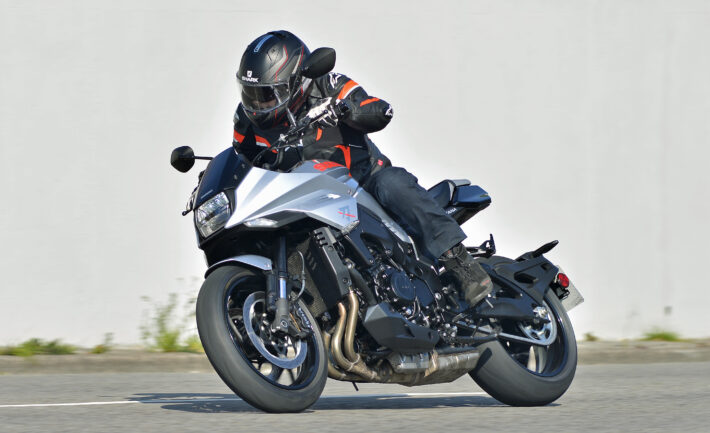
That rarity also applied to Suzuki’s B-King of 2008 – and those are going up in price now, as collectors and fans try to get hold of one of the relatively small bikes sold when it was in production.
By the end of my time with the Katana, then, I think I’d managed to overcome my prejudices. It’s a capable, fun bike to ride, with solid performance, a satisfying engine, good sporty road bike chassis and makes a decent fist of the Katana styling, especially in the flesh. If you can live with the fuel capacity, and take advantage of the excellent finance and discount deals available at the moment, you’ll have a definite piece of Suzuki history. And maybe a rare, desirable, future classic too…
TECH HIGHLIGHTS
Engine
The same as the GSX-S1000 motor, which is a variant of the legendary 2005 GSX-R1000 engine, retuned for 150bhp and modern emissions compliance. Standard layout – 16 valves, double overhead camshafts, inline-four cylinder, water-cooling. Decent power output but a little light on modern technology aids – no quickshifter, wheelie control, launch control, cruise control or ride-by-wire throttle.
Frame/swingarm
Same as the GSX-S1000 frame – fabricated aluminium twin-spar, with a 2016 GSX-R1000 swingarm. Nice enough, but some years back in terms of tech and design.
Suspension
Solid road-spec: fully adjustable 43mm USD front fork and preload/rebound damping adjustable rear monoshock, both by Kayaba.
Brakes
Decent cast monobloc Brembo front calipers with 310mm discs and standard ABS. No cornering functions or other bells/whistles.
Electronics
Neat monochrome LCD dashboard with useful trip functions, gear indicator, fuel gauge, etc. Basic three-level (plus ‘off’) traction control.
Accessories
Suzuki does a neat range of styling bolt-ons, including the dual-colour seat, carbon front mudguard, flyscreen, carbon engine covers, coloured Brembo calipers, heated grips, crash protectors, tank bag, extra graphics kits, wheel stripes and tank protector.
Price: £10,499 (October 2020)
Engine: DOHC 16v, inline-four, l/c, 999cc
Bore x stroke: 73.4x59mm
Compression ratio: 12.2:1
Carburation: EFI, 44mm dual-valve throttle bodies
Max power (claimed) 150hp@10,000rpm
Max torque (claimed) 79.7ft lb@9,500rpm
Transmission: six speed gearbox, wet slipper clutch, chain drive
Frame: fabricated aluminium twin-beam
Front suspension: 43mm USD KYB fork, fully adjustable
Rear suspension: aluminium braced swingarm, KYB monoshock with rebound/preload adjustability
Brakes: twin 310mm discs, four-piston Brembo monobloc radial calipers (front), 250mm disc, single-piston caliper (rear), Bosch ABS.
Wheels/tyres: cast aluminium)/Dunlop Roadsport 2, 120/70 17 front, 190/50 17 rear
Rake/trail: 25°/100mm
Wheelbase: 1,460mm
Kerb weight : 215kg
Fuel capacity: 12 litres
Colours: silver or black
Equipment: Three-stage traction control (plus off), ABS.